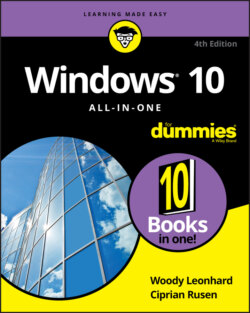Читать книгу Windows 10 All-in-One For Dummies - Ciprian Adrian Rusen, Woody Leonhard - Страница 41
A Brief History of Windows 10
ОглавлениеSo you’ve decided to stick with Windows 10? Good.
Pardon me while I rant for a bit.
Microsoft darn near killed Windows — and most of the PC industry — with the abomination that was Windows 8. Granted, there were other forces at work — the ascendancy of mobile computing, touchscreens, faster cheaper and smaller hardware, better Apple devices, Android, and other competition — but to my mind, the number one factor in the demise of Windows was Windows 8.
We saw PC sales drop. After Windows XP owners replaced their machines in a big wave in late 2014 and early 2015, responding to the end of support for Windows XP, we saw PC sales drop even more. Precipitously. Steve Ballmer confidently predicted that Microsoft would ship 400 million machines with Windows 8 preinstalled in the year that followed Windows 8’s release. The actual number was closer to a quarter of that. Normal people like you and me went to great lengths to avoid Windows 8, settling on Windows 7.
Windows 8.1, which arrived a nail-biting year after Windows 8, improved the situation a bit, primarily by not forcing people to boot to the tiled Metro Start screen.
The team inside Microsoft that brought us the wonderful forced Windows 8 Metro experience was also responsible, earlier, for the Office ribbon. Many of us old-timers grumbled about the ribbon, saying Microsoft should at least present an alternative for using the older menu interface. It never happened. Office 2007 shipped with an early ribbon, and subsequent versions have been even more ribbon-ified since. Here’s the key point: Office 2007 sold like hotcakes, despite the ribbon, and it’s been selling in the multi-billion-dollar range ever since. As a result, the Office interface team figured they knew what consumers wanted, and old-timers were just pounding their canes and waggling toothless gums.
The entire Office 2007 management team was transplanted, almost intact, to the Windows 8 effort. They saw an opportunity to transform the Windows interface, and they took it, over the strenuous objections of many of us in the peanut gallery. I’m convinced they figured it would play out like the Office ribbon. It didn’t. Windows 8 is, arguably, the largest software disaster in Microsoft’s history.
Essentially all the Windows 8 management team — including some very talented and experienced people — left Microsoft shortly after that operating system shipped. With a thud. Their boss, Steve Ballmer, left Microsoft too. Ballmer’s still the largest individual shareholder in Microsoft, with 333,000,000 shares at last count, worth $31 billion and change.
In their place, we’re seeing a new generation of managers taking care of Windows. The current head of the Windows effort, Joe Belfiore, oversaw the PC/Tablet/Phone department in the Operating Systems Group at Microsoft. Before Windows 10, he led program management for the Windows Phone team and the effort to create the Metro design language that we hated so much, the disliked Live Tiles, and the much-ignored Cortana.
That said, Microsoft’s traditional PC market has sunk into a funk, and it appears to be on a slow ride into the sunset. Or it may just turn belly up and sink, anchored with mounds of iPhones, iPads, MacBooks, Galaxy Tabs, and Chromebooks. Or maybe, just maybe, Windows 10 will breathe some life back into the 35-year-old veteran. Yes, Windows 1.0 shipped in November 1985.
However things play out, at least we have an (admittedly highly modified) Start menu to work with, as shown in Figure 2-2.
FIGURE 2-2: The new Start menu should look at least vaguely familiar to just about all experienced Windows users.
